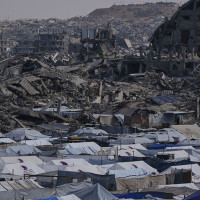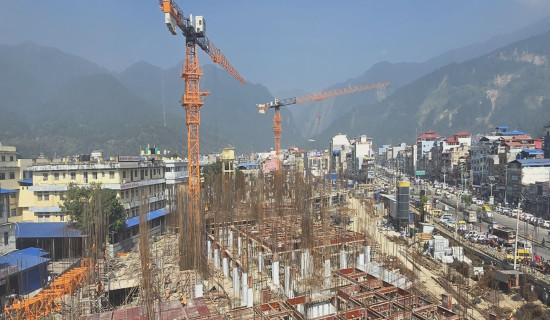- Sunday, 7 December 2025
Prioritise Child Safeguarding Agenda
Nepal has adopted the definition of a child as anyone who has not yet reached their 18th birthday. As a party to the United Nations Convention on the Rights of the Child (UNCRC), the State is obliged to ensure children grow up in a spirit of peace, dignity, and equality, and is required to take steps to implement its provisions. Therefore, Nepal has enacted the Act Relating to Children and created institutions such as the National Child Rights Council.
However, the apex ministry mandated to oversee all related activities—the Ministry of Women, Children and Senior Citizens (MoWCSC)—is chronically under-resourced. This has resulted in poor and tokenistic recognition of Child Protection in Nepal, largely because Child Safeguarding, a very important and integral component of child protection, is almost neglected. Consequently, children enrolled in Nepal's state and private schools are also deprived of adequate safeguarding.
Quality relationships
Some may counter this argument by citing existing national and/or sub-national (local level) frameworks, guidance, and procedures relevant to the concept of child safeguarding. However, a true understanding of these provisions is minimal among personnel involved in management or teaching/learning activities. This can be evidenced by the state of Nepal's children, who are exposed to hazardous physical and emotional environments. In fact, these should be provided: safer infrastructures/ materials, and the emotional support and acceptance fostering quality relationships. Tragically, many children are killed due to the absence of proper safety arrangements at home, on the way to/from school, inside classrooms, and during leisure time.
The state of poor safeguarding, often reflected in regular reports, surfaces regarding corporal punishment, inappropriate touching, and bullying incidents in schools. Sadly, many more go unnoticed. Furthermore, many children are deprived of proper sanitary hygiene at school due to the absence of adequate toilet facilities. Tragically, some children lose their lives or suffer life-changing injuries while traveling to or from school, often due to falls, drowning, animal attacks, or road crashes.
Many others are injured while playing in school playgrounds. Additionally, some children contract contagious infections or diseases from their peers. Similarly, some are unfairly disciplined because teachers fail to recognise underlying issues like a visual impairment. This occurs because teachers are merely involved in "teaching" activities, with only a very small number paying attention to a child's physical and mental state when they are in the classroom.
Child safeguarding is the process of protecting children from harm and promoting their welfare by preventing the impairment of their health or development. It involves a range of actions, from prevention to intervention, and is the responsibility of everyone who comes into contact with children. Therefore, safeguarding learners under the age of 18 years should be an inseparable duty for an educational institution.
Safeguarding issues can manifest in diverse forms and appear without warning. Therefore, constant awareness and vigilance against these potential harms in all environments are essential. Physical Abuse is a major and visible form of failed safeguarding that involves the physical well-being of an individual. It encompasses direct acts of harm, such as being hit, slapped, pushed, assaulted, or unlawfully restrained. This includes acts of neglect, such as the denial of basic necessities like food, water, or necessary assistance with hygiene and toileting. Abuse can sometimes take the form of the intentional misuse of medication, which may be difficult to detect. On the other hand, extreme exploitation in the form of human trafficking and forced labour represents the most severe violation of personal freedom and children's rights.
Secondly, the safeguarding framework must address abuses that affect children's emotional and psychological integrity. Psychological Abuse is characterised by emotional harm, threats of abandonment, humiliation, constant control, isolation, verbal attacks, or harassment. At present, cyberbullying and exposure to inappropriate content online via mobile phones are prolific. Many children are vulnerable to Sexual Abuse, whether through physical acts like rape and inappropriate touching, or exposure to indecent content like pornography and sexual photography, with several incidents going unreported.
Educational institutions must also be aware of Discriminatory Abuse. Such abuse occurs when a person is targeted based on specific characteristics, involving unfair treatment, harassment, or slurs related to their ethnicity, gender identity, age, disability, religion or educational performance. These acts not only inflict psychological pain but also often deny access to services and respect, systematically undermining an individual’s dignity and equality.
National policy change
The most immediate national policy change is the decision to stop publishing examination results publicly, ensuring results are accessed only by the individual child or their parent. This will solve the children's biggest fear of being compared. The other widespread but localised issues of neglect and physical harm needed to be understood well before developing a localised safeguarding plan. The issues of playground injuries, poor sanitation, and the tragic failure to prevent abuse or spot special needs underscore an urgent need for a fundamental policy shift. The shift must move from symbolic national policies to concrete, local action.
The Municipalities must be empowered and held accountable as the primary frontline agents for child safeguarding. Unfortunately, when assessing the Local Child Protection Procedures of any municipality (rural, urban, mountain, or Madhes), the attached documents are often copied and pasted without attention to local contexts or needs, serving only to 'tick off' a compliance criteria mandated by the Act Relating to Children.
The initiation to a shift in business as usual could be achieved only when municipalities urgently prioritise resource allocation, conduct mandatory training to equip teachers to focus on child welfare over mere "teaching" job and diligently operationalise existing child protection frameworks to each school. By adopting this localised, community-driven approach Nepal’s UNCRC obligations, could be transformed into a reality of safety, dignity, and equality for every child.
(The author is an injury prevention researcher.)














